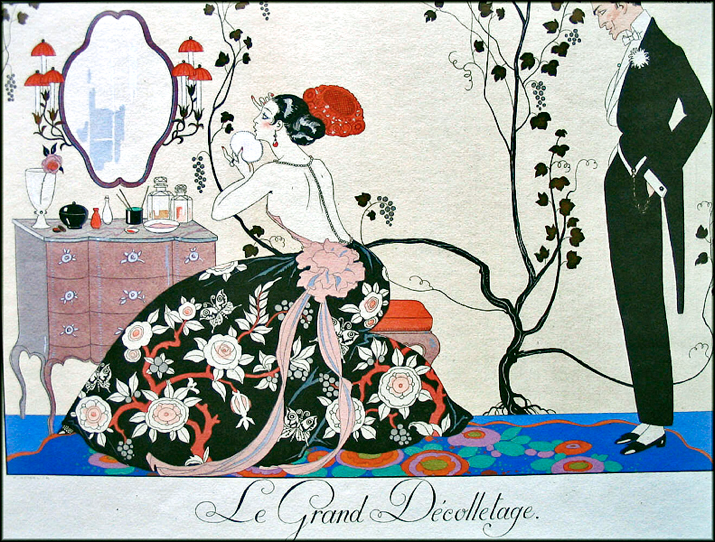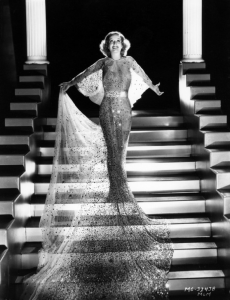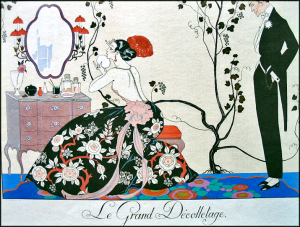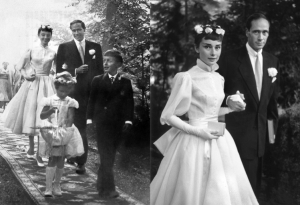Joan Crawford in the MCM film “Dancing Lady,” 1933. (Publicity still courtesy Photofest.)
Dancing Lady was a film about a woman that started from the bottom and worked her way up by marrying a man with money. The different costumes that Crawford wears throughout the film shows a great depiction of what a typical woman’s attire would be during the 30s. From the still shot, Crawford is on top of the stairs wearing a lavishly beaded dress with a classic silhouette. The silhouette is fitted through her body and till her knees, then flares out into a long train. Films during this time were known for the classic Hollywood style when people would always be dolled up to go anywhere in the town.
When looking at this image the way that the dress fits Crawford’s body is unbelievable. The dress fits her like a glove, but what drew me into to this image is the amount of detail that was put into the dress. The beading on the dress shows how lavished the 30s was in Hollywood. Production took another it to another level when it came to costume for a film. Viewing the image, Crawford’s hair and makeup was perfect making her look like a porcelain doll. The background lighting shining through the dress made her glow so bright because of the shine of the beads on the dress. I would like to look into Hollywood glamor even more.
Comparing my designs to Hollywood glamor I would have to say they are different from each other because I tend to design ready to wear garments that everyday people could wear in their life. I feel that during the 30s people would take the time to get ready by putting on a full face of makeup and being very particular of what they would wear on an everyday basis. Me on the other hand, the garment would help people show their beauty with patterns and shape in the fabric. Looking back at old films, actors would rely on their bodies to show off simple shiny dress. Sex appeal was a big selling point in film during this time, showing skin mostly their legs or their cleavage of their breast. My design is more covered up and not relying on sex, unusual to the main selling point of other brands. Its interesting to read that this was a point for the 30s in glam to have in their branding.
George Barbier, “Le Grand Decolletage” from Le Bonheur du Jour ou Les Graces a la Mode, Paris: Chez Meynial, 1924.
George Barbier was well known for his Art Deco illustrations during the 1882-1932 in France. His illustrations were mainly designs for theater, ballet costumes and couture fashion and books too. The subject matter of his well-known prints were upper class people in the setting of parties. Shown in their extravagant beaded, draped, well-tailored clothing. Showing the life style that people lived and wanted. Art Deco was shown in a colorful bold way, illustrated with people in different types of settings around that time.
What drew me into this print was the setting and how the two figures interacted with each other. Their body language, with the woman putting on her makeup and the male figure hovering over her shoulders with a stern face. The floral print on her dress mixed with the wallpaper and different textiles in the print makes the setting have a dream like feel to the piece making it interesting to look at. I want to learn more about the illustration during that time.
The well-tailored clothing to the body to show the figure in connection to my personal design is because I like to design well-tailored clothing that complement the human body. Clothing should not hide the human figure and we should not be ashamed of the different types of bodies that are out there. The uses of color I appreciate when looking at fashion illustrations because it gives me the ability to see the whole package of what the artist/ designer was thinking about. In my sketches, I try to uses as much color in my sketches to convey my ideas.
Audrey Hepburn and Mel Ferrer wedding day, photographed by Ernst Haas. Burgenstock, Switzerland, September 25, 1954, Aduery Hepburn wearing Hubert de Givenchy and a crown of roses designed by Jeanne-Marie.
Hepburn is wearing an untraditional wedding dress. The length of her gown being above the ankle is called a tea length. Wearing this style of dress was common during the time but still seen as a non-traditional wedding dress for the fact that the length of her dress was above her ankles and most wedding dress were floor length to show modesty. Even though her ankles are shown, the top half of her dress was covered well in a high neck line with long sleeves. Hepburn was also seen not holding a bouquet of flowers but was seen wearing a crown of roses on top of her head. Tying in with the idea of not being traditional. Designer Givenchy was a well-known French designer known for his couture designs and his relationship with Harper’s iconic looks throughout her career. He designed her attire for Funny Face in 1957 and Breakfast at Tiffany’s in 1962. The two grew a close bond throughout the years of working together.
Wedding dresses during the 50s were a break of traditional wedding dresses seen in this photo. Throughout the years, we have known wedding dress to be long and to be modest by not having the women show their ankles to the public on their wedding. Choosing this iconic figure in fashion and film, seeing her vulnerable stages of her personal life of her getting married encouraged me to want to look more into the different types of silhouettes of wedding dress during the 50s and how that influenced women then and now.
Wedding dresses have had a big impact on my design inspiration. I think designers that make wedding dress for a living are amazing and smart designers that I respect because they have only one color pallet to work in for one garment and have to rely on structure and embellishment to make a dress. That would be a hard job to do for the rest of your life. That’s what sparks my interest with wedding dresses throughout the times.




